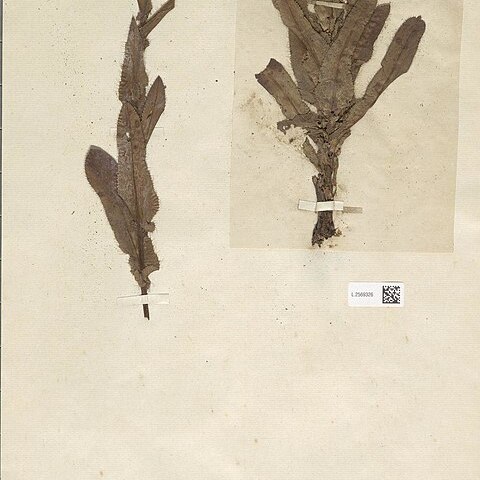Glabrous perennial herb with clustered, thick, rather fleshy, fibrous roots, ±(0.1-)0.2-1.5(-1.75) m. tall. Stem slender to rather stout, striate, with numerous long, slender and ascending to 1-numerous divaricate branches above, stem with a terminal umbel subtended by 2 opposite or whorls of 3-6(-8) branches which (as with the lower branches) have a terminal and 1-2 lateral umbels; in large forms these and the lower branches occasionally with whorled umbels. Basal leaves narrowly obovate to oblong-obovate or oblong, all long-tapering to the base or al! ± truncate or cordate at the base, or the outer truncate and the inner attenuate, 3.5-4 x 0.8-6 cm, with broad, shallow, acuminate teeth terminating in ±1-4 mm cilia; petiole and tapering indistinctly demarcated sheath ±1-9 cm; lower stem leaves sessile, auriculate with dark cilia, ±4-10 mm long, rather abruptly decreasing above the lower 2-3 or even above the rosette, or gradually decreasing in larger forms; upper stem leaves small, the uppermost subtending the final (2-)3 umbels or whorl of umbels bract-like, ciliate to remotely toothed. Umbels rather few to very numerous; bracts 8-11, usually alternating larger and smaller, spreading, white to black or dingy purple on the upper surface, greenish with 3-5 slightly anastomosing veins below, narrowly lanceolate and acute to broadly ovate and bluntish to apiculate, the larger 4.5-15 mm from tip of bract to tip of peduncle; flower-head 3.5-8 mm in diameter. Sepals broadly deltoid-ovate, acute to subacute, ±0.75 mm Petals white to slightly pink or greenish, rather narrowly obovate, ±1.5 mm Fruit ±2 mm, white verruculose, angles rather sharp; styles divergent, straight, rigid, ±1.25-1.5 mm.
Plants 250-600 mm high, often with a well-developed rhizomatous rootstock up to 40 mm long and 10 mm in diameter. Radical leaves broadly oblanceolate to spatulate; erect and coriaceous, with coarse, forward-pointing marginal setae. Petioles and basal part of stem often bright purple, and stem base angular in transverse section. Fruit are narrowly obovate with squamose outgrowths in longitudinal lines and at the apex.
Plants 200-700 mm high. Radical leaves usually long, oblanceolate to linear-oblanceolate, with the base narrowly tapering. Margin obscurely crenate-serrate. Seta (fine hair) on tip of each serration more or less inflexed (and thus situated, above the adaxial surface of the lamina). Mericarps (based on limited, immature material) with dense, evenly distributed squamose outgrowths.
Perennial herb, 0.1-0.3 m high, when in flower up to 0.5-1.2 m high. Leaves rosulate at base, erect, concolorous, margins barely to conspicuously setose, inflexed setae absent. Flowers in a large panicle of capitula. Involucral bracts prominent, white, in 2 subequal series of 5 each, usually > 10 mm long. Flowering time late summer.
A herb. It keeps growing from year to year. It grows 1.2 m high. The roots are fibrous and in thick fleshy clusters. The stems are slender and branched. The leave are simple and alternate. The leaves are in a ring at the base. The leaves on the stem are smaller. The flowers are in heads.
Perennial herb. Flowering stems up to 0.7 m high; erect. Leaves radical with a few cauline, simple; blade linear-spathulate to narrowly linear-obovate, tapering gradually at base. Flowers: involucre with bracts narrowly ovate, apices acuminate; white; Nov.-Feb. Fruit rugose.
Herb, 0.5-0.7 m high. Radical leaves linear-spathulate to linear-oblanceolate, tapering gradually at base; low marginal teeth on lamina; cauline leaves distant. Involucre of 10-15 mm in diameter, 10 rigid acuminate bracts, triangular ovate. Mericarps rugose. Flowers white.
Herb, up to 0.7 m high. Radical leaves narrowly oblong, lanceolate or oblanceolate, obtuse or rounded at apex; serrate-setose. Involucre 10-15 mm in diameter, of 10 rigid, acuminate bracts, triangular ovate. Mericarps rugose. Flowers white.
Herb, 250-500 mm tall. Radical leaves oblanceolate acuminate, dentate-serrate; cauline leaves numerous. Involucre 10-15 mm in diameter, of 10 rigid, acuminate bracts, triangular ovate. Mericarps rugose. Flowers white.
Herb, 0.15-0.50(-0.70) m high. Radical leaves rosulate, linear-lanceolate, acute to obtuse, serrate-setose. Involucre 10-15 mm in diameter, of 10 rigid, lanceolate acuminate bracts. Mericarps rugose. Flowers white.
Herb, 200-300 mm tall. Radical leaves linear-lanceolate, petiolate, margins crenate-dentate; cauline leaves numerous, erect, linear to linear-lanceolate, smaller than radical. Flowers white.

